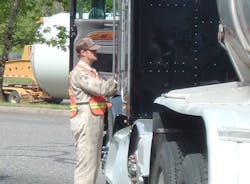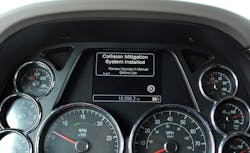What should a safety incentive program look like? Enforcement weighs in
The roadside inspection piece of the truck safety puzzle is “tried and true,” so enforcement officials have been reluctant to change it even as the trucking industry continues to voice concerns about the way the government uses the inspection data in the Compliance, Safety, Accountability (CSA) program.
But, as Steve Keppler, executive director of the Commercial Vehicle Safety Alliance (CVSA) explains it, the Beyond Compliance initiative could lead to improved highway safety independently of any tinkering with established roadside practices. Indeed, such an incentive system could actually help inspectors better target the truly unsafe trucks on the road while also rewarding the trucking companies who do more than is required.
Keppler recently walked me through his organization’s thinking.
In a letter to the Federal Motor Carrier Safety Administration last fall, CVSA called for a pilot program to explore the possibilities of Beyond Compliance, saying such an incentive program could lead to “a positive sustained behavioral change” among carriers.
Broadly, a pilot would address questions such as what types of safety solutions should be eligible, how should they be evaluated, and what’s the proper government role in the process? While the letter was relatively recent, CVSA has been pondering the idea for several years, Keppler explains.
Not long after CSA went in effect in late 2010, trucking representatives approached CVSA about how difficult it is to improve their safety scores: Under the formula, only clean inspections and the passage of time will reduce a score.
So the industry wanted to make sure that “every single contact” an enforcement officer had with a carrier would be documented. But that’s easier said than done.
“There are a lot of screening activities that go on,” Keppler says. “To manage the queue at the scale house, sometimes officers will just do a quick check on licenses and documentation and send them on their way, and you’ve also got electronic programs to screen vehicles. So the industry wanted us to come up with a way document all that to help with CSA.”
A study group generated some options and a plan, but the CVSA executive committee didn’t support it.
“Not because the issue doesn’t have merit,” Keppler insists. “They understood the industry’s concerns. But the point they made was that the data and the CSA methodology shouldn’t drive enforcement. We should not be changing enforcement practices because of how CSA treats the data. That’s not our issue, that’s FMCSA’s issue.”
Indeed, as Keppler explains, the inspection program has been around for decades—since long before CSA.
“It’s tried, it’s true. It’s tested, it’s standardized,” he says. “Yes, we have our data issues, but by and large, we have a very good, strong, uniform program across the continent. You don’t want to start playing around with that.”
Instead, CVSA began to explore alternatives—and the alternative compliance concept was born.
“The best compliance is voluntary compliance,” Keppler says. “When you look at the safe fleets and the safe companies, they are proactive. Just because you comply with the regulations doesn’t mean you’re going to be safe—and the safe fleets know that.”
A path forward
So CVSA is looking for “a path forward” to reward fleets for making good decisions and safety investments.
Keppler notes “the bell-curve effect” in enforcement, with most of the attention going to the ends of the curve: On one end of the graph, the safest fleets are praised and held up as exemplars; on the end are those carriers with the worst safety records.
“But the ones in the middle are forgotten about, and they’re making decisions every day about where they’re putting their money,” Keppler says. “Many of them, unfortunately, view safety as a cost and not an investment. And sometimes safety is put aside just to keep the wheels moving.”
So the notion behind Beyond Compliance, for CVSA, is to give trucking companies a reason to make the long-term safety investment even when immediate business demands might be pressuring them to defer that spending—especially when the competitor “down the street” isn’t doing it either.
“We have plenty of research on a number of systems and solutions that have a positive impact on safety,” Keppler says. “Some people would like them to be mandated, but they’re not right now. So why shouldn’t we be trying to promote them, to give the folks in the middle an incentive to jump off on the right side of the fence to improve safety?”Additionally, fleets are more likely to sustain a behavior if it’s voluntary, he suggests. And, as more and more of the industry adopt these safety systems, the unsafe carriers “will become more obvious” to roadside enforcement.
“Some people respond to enforcement and fines, some respond the incentives—so you need to have a different set of tools in your tool box to deal with how people are going to change their behavior for the long term,” Keppler says.
He compares such an incentive plan to the SmartWay program, in which EPA recognizes carriers for investing in fuel-efficient equipment. Similarly, an adjustment in CSA scores would be the incentive that helps carriers make a business case for safety investments. Of course, other incentives could be explored in a pilot program as well.
Also to be worked out is what role enforcement should play—and how any increased responsibilities would be funded in a time of very tight state and federal budgets. And this despite the 20-to-1 benefit-to-cost ratio of enforcement programs, the details of which CVSA can demonstrate “in spades,” Keppler adds.
Keppler envisions a system in which auditors would make a site visit to a fleet that asked to be recognized for installing a collision warning system, for instance. If the fleet had indeed installed the equipment, roadside inspectors might subsequently verify the equipment was still working properly.
“If it becomes a lengthy or exhaustive type of thing, that’s where we could potentially run into issues,” Keppler says. “Is the amount of effort, and the cost of the investment, going to show a positive return in terms of safety? We don’t know the answers—that’s why the pilot needs to be done.”
FMCSA's Beyond Compliance program is open for public comment through June 22.
About the Author
Kevin Jones
Editor
Kevin has served as editor-in-chief of Trailer/Body Builders magazine since 2017—just the third editor in the magazine’s 60 years. He is also editorial director for Endeavor Business Media’s Commercial Vehicle group, which includes FleetOwner, Bulk Transporter, Refrigerated Transporter, American Trucker, and Fleet Maintenance magazines and websites.
Working from Beaufort, S.C., Kevin has covered trucking and manufacturing for nearly 20 years. His writing and commentary about the trucking industry and, previously, business and government, has been recognized with numerous state, regional, and national journalism awards.



